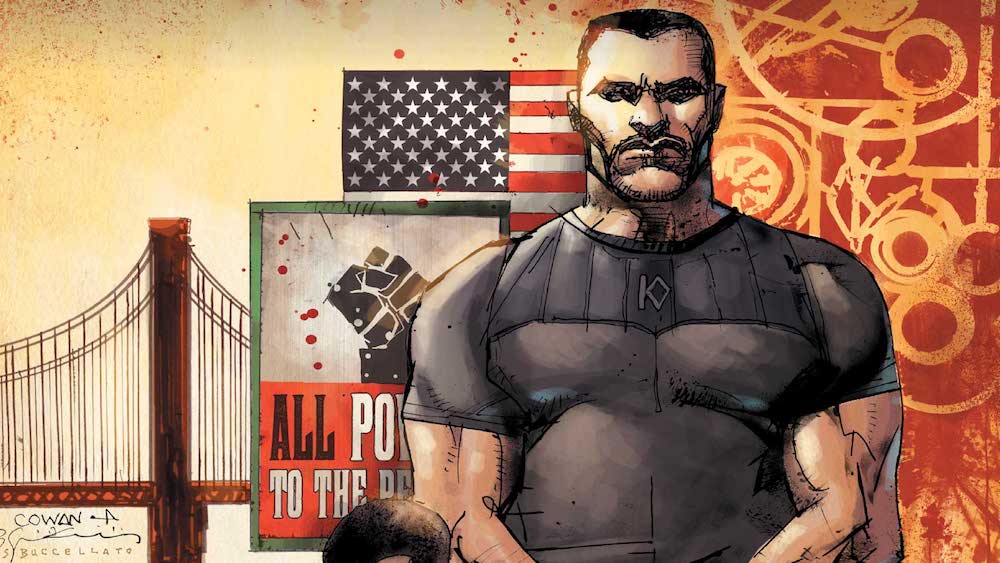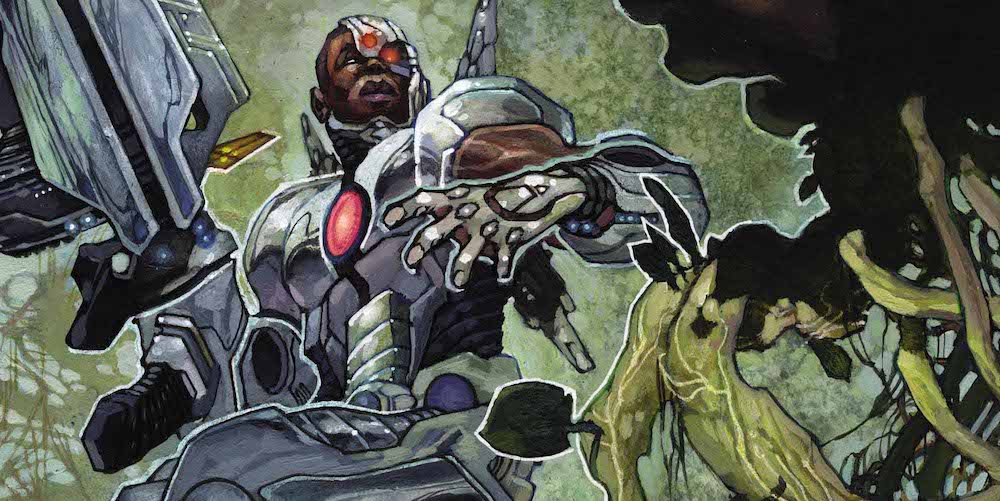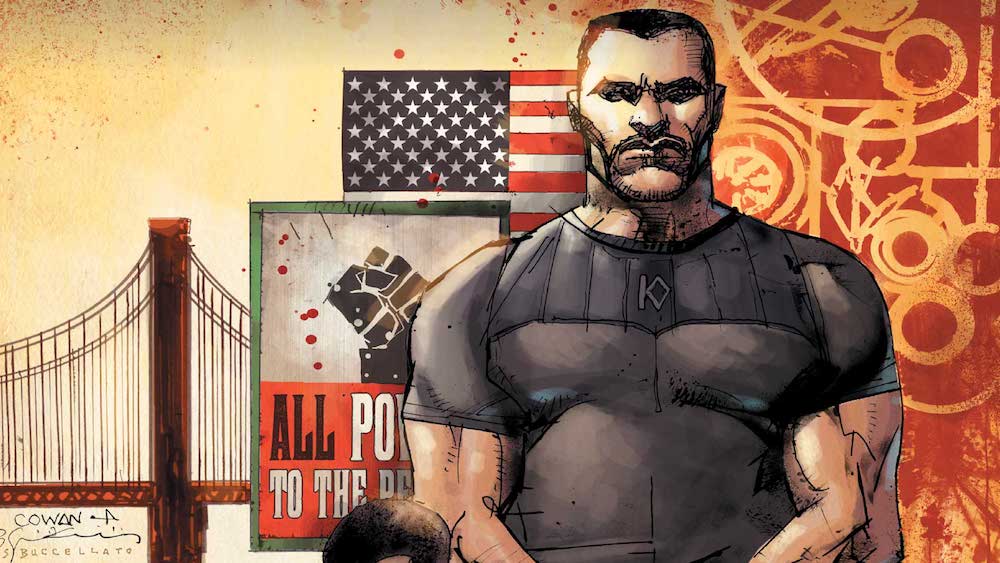
This week, our spotlight title is Michael Cray #1, a new title in the Wild Storm universe that is also a fine stand-alone comic, though it might require some familiarity with the basics of Oliver Queen.
Other issues of note this week include Batgirl & the Birds of Prey #15, in which nearly every DC heroine guest-stars;
Supergirl #14, featuring a team-up with Kenan, the New Super-Man; Tim Drake versus..himself?…in Batman: Detective Comics #966; and the debut of a new Ragman story.
Plus reviews of all this week’s DC Comics.
Warning: Major Spoilers Below.
Spotlight Title:
Michael Cray #1 – Bryan Hill, Writer; N. Steven Harris, Penciller; Dexter Vines, Inker; Steve Buccellato, Colorist
Ray – 8/10
Corrina: Excellent Beginning
Ray: I would describe myself as skeptical when this spinoff was announced because I’ve found the main Wild Storm series less than compelling. It’s got a lot of good ideas, but a slow pace and confused structure that has kept it from taking off. However, this spinoff starring secret agent Michael Cray, who recently defected from the evil IO after finding out he was dying, has a much clearer human focus that makes it the best story set in the Wildstorm Universe in years. The issue opens with a series of split panels, showing Cray growing to adulthood inter-spliced with scenes of him in action as an agent. These humanizing scenes go a long way towards showing us what drives him as a character.
Now, a member of the top-secret Executive Protection Services, he’s still doing the same thing he was always doing – taking out high profile targets – but ostensibly for the good guys. And his first target…is Oliver Queen. But this is another world and another Oliver Queen. This Oliver Queen is a cruel, conniving gentrifier, taking over the city piece by piece. However, he’s a lot more than that – he’s apparently never left the island in his mind, recreating the island in his own private lair, kidnapping people, and forcing them into some sort of deranged version of the Most Dangerous Game. Is this Oliver Queen? Not any more than Injustice Superman is Superman, but maybe there’s a bit more in the way of common DNA there. Either way, it’s an intriguing start and has a lot of the dark, grindhouse vibe that the Wildstorm Universe used in some of its best comics.
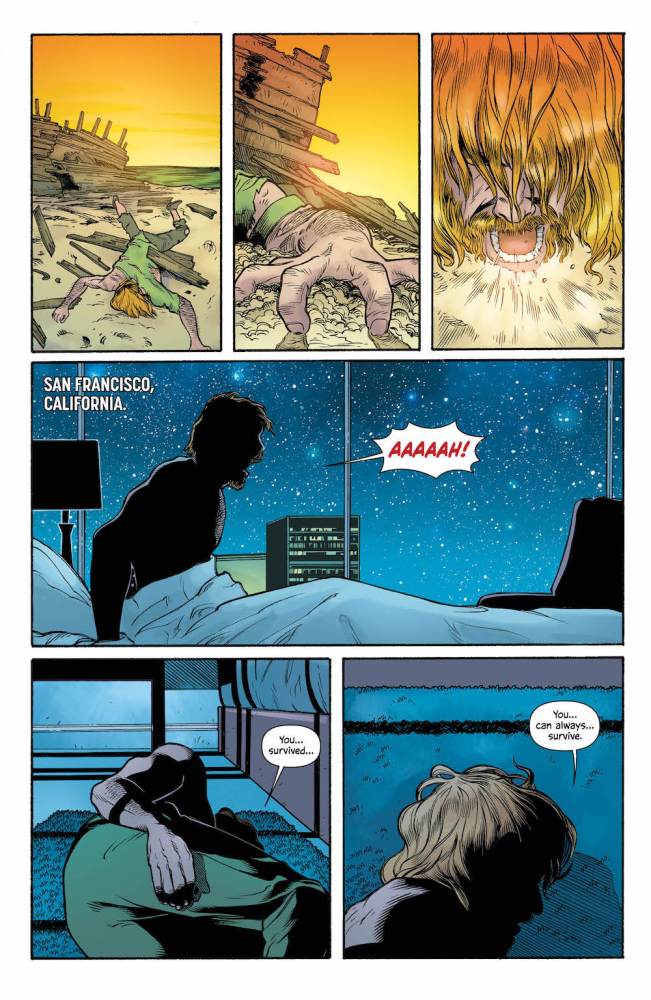
Corrina: As unfamiliar as I was with the Wildstorm universe, the relaunch left me baffled, a confusing mix and match of the cast with a plot that seemed to go everywhere and nowhere. But this series is different. The focus on two people helps, especially since they appear to already be mirror images of each other: Cray, the black ops operative who looks to finally do things the right way; and this world’s Oliver Queen, who is broken and wrecked from surviving in a dark world.
It’s a compelling and emotional opening issue, focusing squarely on the themes of morality and justification for violence. The art by Harris (Watson & Holmes) makes terrific use of shadows and light and treads more lightly with gore than I would have expected from a Wild Storm comic. This has me hooked on one of the titles in this universe for the first time since Ed Brubaker’s Point Blank.
Near Perfect: Ratings 9-10
Supergirl #14 – Steve Orlando, Writer; Jose Luis, Penciller; Norm Rapmund, Inker; Michael Atiyeh, Colorist
Ray – 9/10
Corrina: Super-Hero Support
Ray: In the aftermath of the biggest Supergirl story yet, Orlando wisely dials back and does a character-driven issue that kicks off what has the potential to be one of the best friendships in the DCU. Kara and her fellow teenage Super Kenan Kong takes the fore, as after Kara consults with Superman about her new jacked-up powers, he sends her for training with Kenan’s mentor I-Ching. The training segments are strong, as Kara’s science background clashes with I-Ching’s more spiritual bent. Orlando’s understanding of Kara’s roots as a scientist has really enhanced this series. However, before Kara can master her powers and dial them back, the two Supers find themselves pulled into a conflict in nearby Mongolia.
Much like Yang, Orlando seems to be interested in a bigger, more international DCU. When’s the last time you saw a story set in Mongolia? Here, though, a conflict is brewing as a Rocket Red soldier from Russia crashes in a Mongolian village, and things spiral from there. The Rocket Red is on a secret mission and reacts with belligerence, while the villagers feel threatened and get ready to attack. The language barrier only makes things worse – and two foreign superheroes don’t immediately help. Points to Orlando for remembering that Kara landed in Russia in the New 52 and knows that language! The biggest strength of this issue is the authentic nature of Kara and Kenan’s characters, and the triumph of (mostly) non-violent conflict resolution. Can these two be on a team regularly, please?

Corrina: With Supergirl’s life unraveling along with her powers, she does something smart: look for help. Kenan might not have been the person I expected to become that help but the team-up works well, as Ray noted. The clash between Supergirl’s training in science and I-Ching’s mysticism is well-done and Supergirl’s search for balance brings an intriguing new meaning to the “S” symbol she wears.
The segment with Rocket Red was interesting, as it’s one of the few DC comics this week where people work together to solve problems without violence. All we need is a bit of peace, love, and understanding. I’m down for that.
Bombshells United #3 – Marguerite Bennett, Writer; Siya Oum, Luciano Vecchio, Artists; J. Nanjan, Colorist
Ray – 9/10
Corrina: Hope Prevails Here Too
Ray – Easily the best issue of this new relaunch of Bombshells, this series seems to have finally found its groove as an energetic, younger-skewing continuation of the original’s war story. The issue opens with Wonder Woman facing off against Clayface in the refugee camp, as the mud monster grows to impressive sizes and threatens to drown everyone there in the mud. While he’s much more restrained in his usual role in Detective Comics, here he’s allowed to be the kaiju he can be, thanks to Oum’s intimidating art. However, even in this fight scene, we see Wonder Woman show what makes her unique, trying to use her compassion to make him see the light. However, not everyone can be saved, and this Clayface is too bitter, too evil to take the hand she extends – leading to Diana making a sacrifice.
That leads into the second segment, where Diana’s young allies take the fore in her absence (and, they believe, possible death). The art shifts dramatically, as new artist Luciano Vecchio brings a distinct anime, magical girl vibe to the story as the girls harness their own powers and form a squad that reminds me of something out of Sailor Moon. There’s also a great twist in the form of the identity of Wonder Woman’s mysterious herald, which drives home again the point that Diana always feels anyone can be redeemed if they choose it. This new volume has injected a new vibe of youth into the series, both in characters and art. The cast, pared back for now, will undoubtedly expand soon, and I can’t wait.

Corrina: There is definitely something symbolic in the very soil of America turning against those who are not supposedly native-born, though Dawnstar’s inclusion in this arc gives the lie to the fact that Clayface alone can claim to be the guardian of American soil.
And so, it’s the teenage girls that save America from itself, yet another choice in the comic that has symbolic resonance, especially after Diana’s sacrifice. (Do I believe she’s dead? No, but she might be gone for a while.) As Ray said, that’s a very anime thing, as comics in Japan tend to let teenage girls be the superheroes more often than mainstream American superhero comics.
Batman: Detective Comics #966 – James Tynion IV, Writer; Eddy Barrows, Penciller; Eber Ferreira, Inker; Adriano Lucas, Colorist
Ray – 9/10
Corrina: Love Tim. But I Didn’t Need Two of Him
Ray: Tynion mind-bending, time-hopping, continuity-crossing thriller continues to impress, packing more into one issue than some authors pack into an arc. It opens in the future, as the Tim Drake of Tomorrow hunts down Anarky, desperate to find Stephanie. He kills his old enemy, we see the Superman of the future (who looks oddly familiar)…and then an odd blue light teleports him away. In the present, Tim and Tim are battling together against Doomsday, and that’s where the issue loses a tiny bit of a step for me compared to the previous one. You’ve got the creature who took on the entire Justice League, killed Superman, and deposed Darkseid, and he’s being handled by a teenage genius and his grumpy older version. I maintain Doomsday never should have come back after his first appearance.
None of that, though, takes away from the real appeal of the issue, which is the two Tim Drakes playing off each other, learning from each other, and becoming an incredibly dangerous team. At first, the Tim Drake of Tomorrow seems almost fatalistic, believing his bad future where he’s taken over Gotham is fixed. Our Tim, meanwhile, is struck by seeing his future self as Batman – something he’s vowed to never be. And even though I think Doomsday’s presence in the issue detracts from it, Eddy Barrows draws the hell out of this monster. Then there’s the last few pages, which will be what everyone’s talking about, as Tim of Tomorrow finds out that our Tim has no memory of Conner Kent – which clues him in that the past’s been changed. He betrays Tim, leaving him trapped in the prison, and Tim’s battle to get free – and now, we know, find his friends – continues. Exceptional as always.

Corrina: The more creators use flashbacks, multiple versions of people, and future flash-forwards, the less this kind of narrative works on me. That’s the case with this second chapter of Tim Drake’s rebirth story and resistance to his captivity. I like that he’s basically fighting the worst version of himself but I could have done with a less literal version of it. That the flash-forwards are mixed into the narrative is confusing and muddles it. I should be interested in them because there is, overall, great characterization and Barrows is doing a fine job with the art, as you can see from the above splash page. But I know this is all going to be undone, so it’s hard to feel the tension in this storyline.
Mister Miracle #3 – Tom King, Writer; Mitch Gerads, Artist
Ray – 9/10
Corrina: Deep Dive Into Personal Darkness
Ray: King’s experimental storytelling continues to push boundaries in a way no other book at DC can match. That doesn’t mean it’s always perfect – it can occasionally cross the line into genuinely uncomfortable, as it does in the opening segment of the issue when Scott relates an unfathomably bleak tale from the Holocaust as a way to illustrate just how warped Granny Goodness – who died last issue – really was. While it’s a good segment, it also kind of feels…wrong. I’m not sure if this story was true or not, but there had to be a better way to do this scene. From there, though, the issue delves deep into the way this war is tearing down all the members of the cast. Scott Free is trying to get back into his life as an escape artist but is still clearly struggling with the demons. And Barda doesn’t really seem to want to listen.
That’s nothing, though, compared to what the war is doing to the other New Gods. Forager, who is getting his starring role in the Allreds’ miniseries, here confronts Scott over the abusive way his fellow Bugs are being treated by Orion’s orders – only to be assassinated by Lightray, who makes clear that Orion as Highfather ordered the execution and will tolerate no dissent. When Scott confronts Orion about the war and about his own demons, Orion lashes out at him in a brutal beating that makes clear just how far gone this new Highfather really is. While this is a cosmic story, it’s essentially a story about depression, post-traumatic stress, and inner demons. King seems determined to push buttons with this issue, and he may have pushed a few too many this times. But I salute the effort.
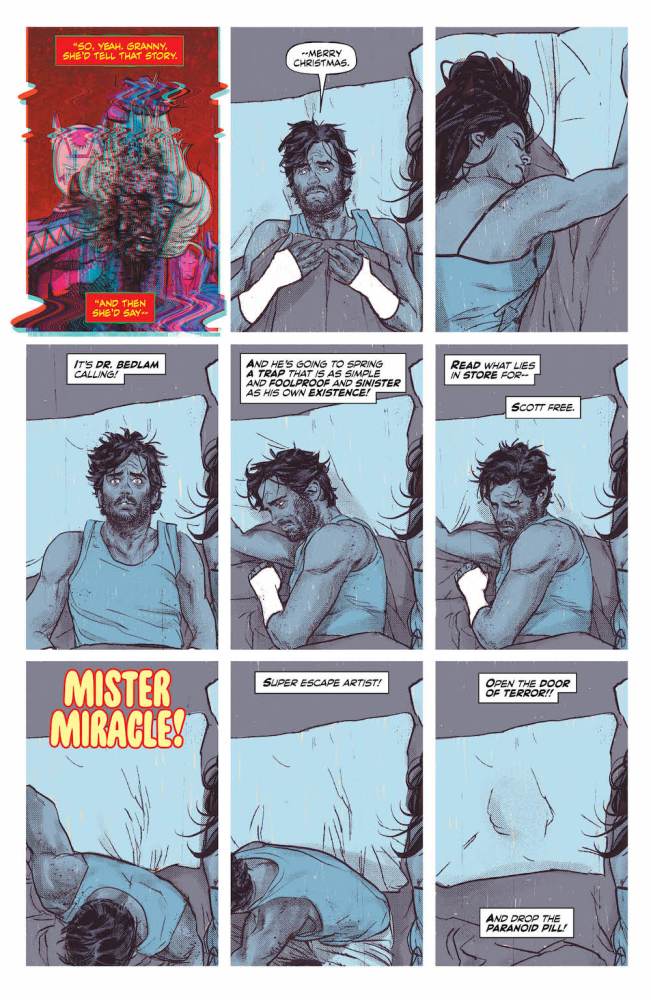
Corrina: One of the questions I’ve used to evaluate work is “how does this make you feel and how strongly?” This issue is dripping with depression, loneliness, and unease, and that is the intent, so I’d call it a success on that point alone. But my own expectations for this book are interfering with the experience of what is actually is. It’s about a Mister Miracle who has lost all faith, especially in miracles. I’d hoped for the opposite, a version of Scott Free where he was able to perform miracles of a sort for himself and others surrounding him. I’d also hoped for more connection between Scott and Barda and instead, they are alienated from each other.
I’d hoped not to be trapped with an increasing descent into war but I’m right there with Scott, falling off the cliff.
Split Decision: Ragman #1
Ragman #1 – Ray Fawkes, Writer; Inaki Miranda, Artist; Eva De La Cruz, Colorist
Ray – 6.5/10
Ray: The character of Ragman is one of the few Jewish characters in the DCU, and precedes their most famous Jewish hero Batwoman by many years. Not only that, he’s always been deeply rooted in Jewish culture and mythology. Thus, this new horror-accented remake of the character by Ray Fawkes and Inaki Miranda came as a disappointment to me. The original rags were an artifact passed down through the generations of Rory Regan’s family, designed to serve as a defense for the family and the people. The new take turns the rags into a secret artifact buried in an ancient tomb in Israel, that Regan dug up with a rogue team of special forces agents. And they’re hungry, coming off much more like a ravenous monster than an agent of justice.
There’s one unavoidable comparison here, and that’s to the iconic Marvel Comics villain, Venom. Ordinary, anxiety-ridden guy with a carnivorous costume right out of a horror movie? That’s not Ragman. Where this issue is fairly strong is in its art. Inaki Miranda is a master of creepy visuals, and he really gets the chance to show that off here. However, the story structure – jumping back and forth between that fateful mission in the tomb and the present day – doesn’t make it very easy to follow. You’ve got hints of an interesting story, with distinctive and creepy art, but you’ve lost a lot of what made Ragman work so well in past stories like Bill Willingham’s Shadowpact. This story feels like a leftover from the New 52 right now.
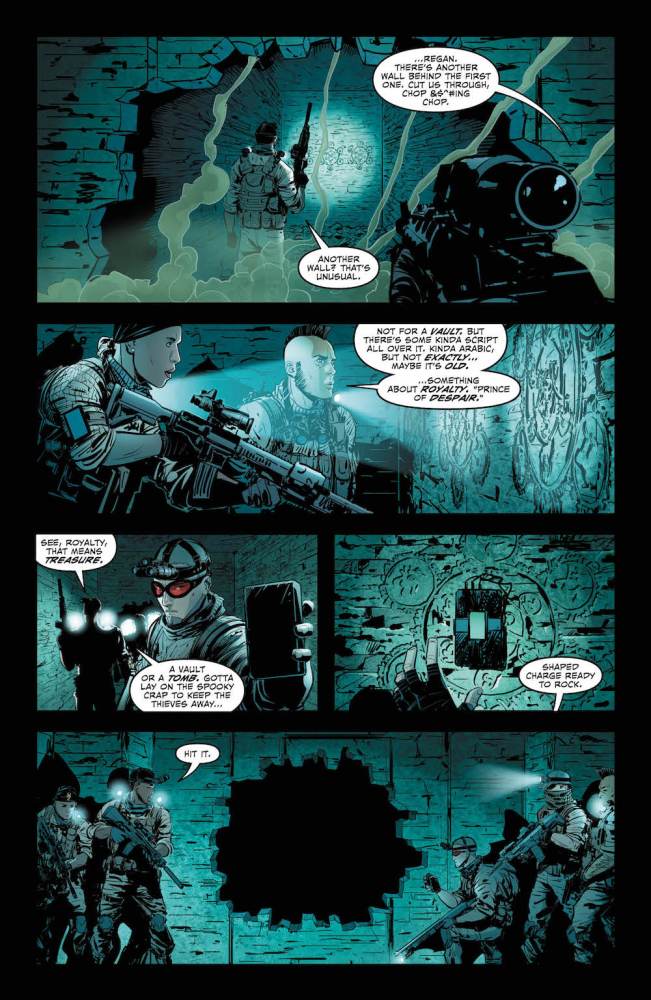
Corrina: Ragman’s origin when I first read the character was that Rory Reagan was imbued with powers via a lightning bolt that killed a collection of his friends, and Rory then absorbed their various abilities and becomes bits and pieces of all of them. It’s obviously a Jewish story, and a very Gotham story, one connected to the Rags and Tatters store. Ragman was the Gotham hero who served in the gutters, the forgotten ones.
Here, that version of the origin has been updated with a mystical connection forged with a group of men who were not heroes, but thieves. I agree that this takes something away from Rory’s connection as a Jewish hero, but I also believe we may be getting a redemption story in which Rory finally accepts his role as champion, and those who are essentially mystically bonded to him will also find a kind of redemption as well. I’m on board for that journey.
Very Good: Ratings 8-9
New Super-Man #16 – Gene Luen Yang, Writer; Brent Peeples, Penciller; Richard Friend, Inker; Hi-Fi, Colorist
Ray – 8.5/10
Corrina: Soul Gazing
Ray: Following last issue’s Death of Superman tribute, Kenan Kong finds himself in a strange limbo, accompanied by the mysterious All-Yang, the evil duplicate of I-Ching. That limbo takes the form of turn-of-the-century Chinatown, and this is where Yang gets the opportunity to take the reader on a visual lesson of the racism Chinese-Americans endured. First up, I do think this segment is extremely important, as this is a part of American racism that often gets completely overlooked. And the two segments show both the overt, violent racism and the subtle, cultural racism, as well as showing the demonization in imagery that occurred. But why is benevolent Gotham detective Slam Bradley cast as a violent racist here? That feels like a needless demonization of a beloved character.
After these disturbing, surreal segments, and Kenan’s reveal of the villain, he finally wakes up in a tube at the Justice League of China’s headquarters. He’s been resurrected via their healing process, and he immediately wants to take off and hunt for where I-Ching is being held. His mother, however, quickly “grounds” him, locking him in a cell for his own benefit, until he’s broken out by the team. The bonding of the Justice League of China – every one of them’s been through their own personal crucible over the course of this series – has been one of the best parts of this series. Unlike many teams, they don’t just feel like coworkers, they feel like family. And next issue promises to pit them against the original Justice League (although I suspect Superman isn’t going to want to fight his new protege). Solid, complex issue that expands the series’ mythology.

Corrina: The segments in the “dreamworld” or the one ruled by All-Yang are some of the strongest yet of this series, simultaneously educating Kenan about the racism in America (especially relevant since the Justice League shows up at the end of the issue) and how history can be rewritten, depending on perception. I expect Slam Bradley was used because he’s one of the few DC characters native to the time period that All-Yang dragged Kenan into, and, of course, Slam and the original Superman once shared a comic.
Is anything resolved in this dreamlike fight? Not particularly, but it provides Kenan with yet another step in his growing up–and part of that growing up is being able to choose your family, and Kenan’s chosen a terrific one. I have come to love the Justice League of China, who are distinct and different from their American counterparts.
Justice League of America #16 – Steve Orlando, Writer; Felipe Watanabe, Penciller; Ruy Jose, Inker; Marcelo Maiolo, Colorist
Ray – 8/10
Corrina: Villain Origin
Ray: Orlando’s big Microverse story goes back to the beginning – literally – and retells the story of the event from the perspective of villain Aron Aut. It all begins with him as a child in a Microverse city, where even from a young age he was obsessed with the concept of nothingness. Then the Quantum Storms came and reduced his cities to nothingness. In that trauma, which reminds me a bit of a cosmic version of the horrific earthquake that devastated Gotham City in the 1990s, it’s implied his mind snapped and his fixation on nothingness turned into something much darker. When he contacted Ray Palmer, and they teamed up to save the Multiverse, he got access to the technology he needed to take his obsession to another level.
However, it didn’t take long for Ray to discover that Aron’s plans weren’t going to stop the destruction of the Microverse – they were going to speed them up. He soon finds himself knocked out and locked in a cell as Aron moves his plot forward. Now calling himself the Null (and building himself a menacing new suit of armor), it’s only the arrival of the Justice League that threatens Aut’s plan to destroy the Microverse. Ray Palmer, although he’s not the star of this issue, winds up taking the starring role as his scientific mind and obsessive determination allows him to get the word out and bring in help – although he didn’t count on Aut recruiting his own allies. It’s a cosmic story with very human stakes, and that’s what makes it work.

Corrina: I feel for Aut. He’s tired of waiting for that axe to fall, tired of trying to stop something that seems inevitable, and has decided his only method of control is to speed along the destruction and eventual oblivion that will be the fat of the Microverse.
But it’s been two issues as we wait for that cliffhanger with the JL, Ray, and Aut confrontation and, while I enjoyed the thematic elements of the flashbacks, I also wish the pacing of this particular arc moved faster.
Dark Knights: Metal #3 – Scott Snyder, Writer; Greg Capullo, Penciller; Jonathan Glapion, Inker; FCD Plascencia, Colorist
Ray – 8.5/10
Corrina: Dreary
Ray: Now that the mythology and setup is over, this issue of Metal plunges us straight into the nightmare as Babatos and the Dark Knights consolidate their hold over the DCU, the Justice League is confronted with their worst fears, and Batman is…elsewhere. The issue opens with an idyllic segment as Superman, Batman, Wonder Woman, and Lois are in Smallville, watching Damian and Jon play in a kiddy rock band. Then Barbatos rips a hole in Bruce’s chest. After a surreal, nightmarish segment, Clark and Diana wake up chained to a massive tower of bodies in Metropolis. With Lois infected with the Doomsday virus, Superman heads off to Gotham to fight Barbatos, and is quickly beaten within an inch of his life by the Dark Knights. Clark only survives thanks to Flash speeding him off to the Oblivion Bar.
This segment brings in some offbeat allies including Detective Chimp – one of Snyder’s favorite characters – Nightmaster, and Doctor Fate, along with post-Resistance “Jon Snow Nightwing”. Tension is high as the surviving heroes discuss their next move, and violence erupts between Nightwing and Robin over whether to go after Bruce. I did feel like this segment dragged a tiny bit by comparison to the rest of the issue and previous issues, though. Too much is devoted to plotting strategy and recapping the events of Gotham Resistance. I suppose that’s the price of making the main series stand-alone. Also, love that Mr. Terrific is just rolling the Plastic Man egg around everywhere. By the end of the issue, Barbatos has made his next move, the surviving heroes are heading off to locations including the Rock of Eternity, and things have gone from bad to worse. It’s the surreal, horrific vibe that manages to keep this story from descending into information overload and keeps it engaging and exciting at all times.
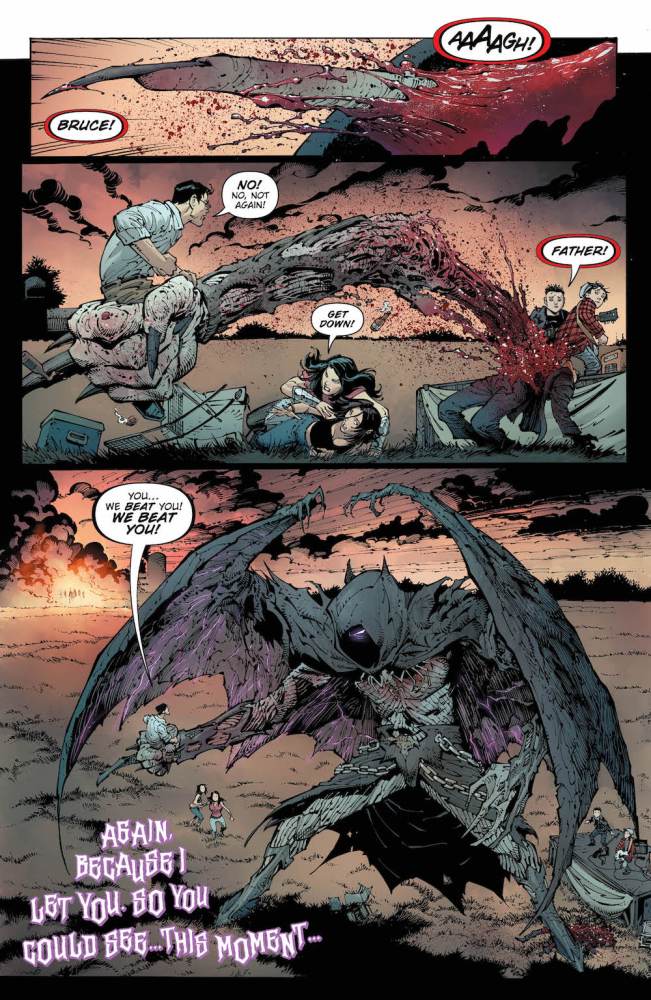
Corrina: Ray might not but I do feel overloaded. There is a ton of explaining and what I like to call “tech talk” about the nature of the universe and the dark metal and these creatures, and the towers and what they’re trying to do. All I needed to know was that the towers were designed to pull this Earth into the Dark Metal world. Why this is what these beings want, I’m not sure because from what we’ve seen of their origins, they originally began all this attempting to help. So, they’re like Aut? If I can’t win, let’s wreck it all?
I suppose that means they’re basically insane, which makes sense in the concept of the story but it doesn’t make any of them more interesting to me. The best part is in the bar at the center of time and Nightwing and Superman’s discussion of what should come next. (Aside: given they’re dealing with alternate versions of Batman, shouldn’t someone bring up that these twisted versions might know Bruce, Diana and Clark’s secret code?) There is probably too much arguing and not enough support and, of course, things are worse at the end. I have reached event fatigue, especially of events where the villains are basically flipped heroes.
Superman: Action Comics #989 – Dan Jurgens, Writer; Viktor Bogdanovic, Artist; Trevor Scott, Inker; Mike Spicer, Colorist
Ray – 8.5/10
Corrina: No Uniqueness to Jor-El
Ray: Last issue pulled back the curtain and showed us Jor-El’s history, as well as his plans for Superman. This issue, though, Superman wastes no time rejecting the idea that he and his family would leave Earth. Jor-El attempts to persuade him by showing him the horrors he’s encountered on Earth, but Superman flies off, and Jor-El decides to turn his attention to Superman’s vulnerable spots – his family. This starts when a deranged man – an acolyte of Oz, I should add – invades the daily planet, ranting conspiracy theories and threatening to blow up the Planet with a suicide bomb. When Steve Lombard tries to attack him, he gets shot, and Lois is able to broker the release of the hostages – including Jon – if she stays behind and tells his story.
Lois taking the lead role here in brokering a hostage situation is good, and I’ve actually found that I enjoy Jurgens’ Lois more than her portrayal in the main Superman book. He’s been writing her on and off for twenty-five years, so he knows the character and her potential inside and out. Her brief face-off with Jor-El after he saves the day is strong, and she may be the one who eventually figures out his secret or plans – because you know he still has a few more. Superman spends the majority of the issue trying to stop a chemical war from breaking out in Africa, while Jor-El finds Jon and works his game on the boy, convincing him how much happier he’ll be when he’s in a place where he doesn’t have to hide – and if the last page shows what I think it does, Jon isn’t the only person who’ll have a wide grin on his face. Probably my favorite chapter of “The Oz Effect” so far.
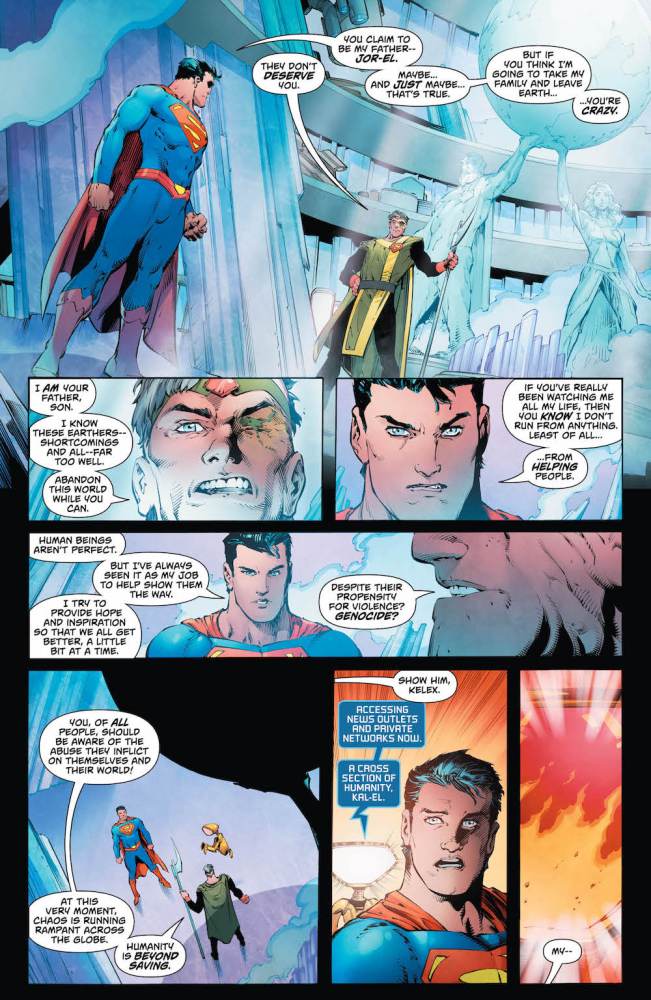
Corrina: Jurgens’ Lois is better than any other current Lois in DC Comics but that’s a low bar. I would rather have seen Lois look to a solution beyond “let’s call my husband for help,” though she gets points for being able to save the rest of the hostages.
Once again, though, I have event fatigue and, so far, Jor-El hasn’t done anything surprising, rather acting as simply yet another Kryptonian who hates Earthlings and believes his son deserves better. The hint that to drive Clark away from Earth, he might kill Lois and Jon, well, we’ve seen that threat over and over too. Since I doubt DC will do it, the story tension is, again, deflated. A solid tale but certainly not Earth-shattering, as it feels the return of Jor-El should be.
The Flash #32 – Joshua Williamson, Writer; Christian Duce, Artist; Ivan Plascencia, Colorist
Ray – 8/10
Corrina: Run To Oblivion
Ray: This issue begins the process of Barry digging out from the Negative Flash powers and trying to rebuild his life, but it starts with him in the darkest place in Central City – Iron Heights prison. At the start of the issue, he’s training in his new powers with the help of Kid Flash. They’re taking on the evil Black Spider and his mercenaries, and are easily able to fend them off thanks to Wally’s growing control of his powers. But once they’re out of costume, it’s clear that a lot of tension still exists between Barry and Wally. And then it’s time for Barry to start his new job with colleague Kristen at Iron Heights. It’s clear from the start that the ruthless Warden Wolfe has no patience for them, and runs a sadistic prison that can rival Arkham Asylum.
It seems like Williamson is gearing up for a story that is going to be a commentary on the prison system, and I salute him. Wolfe seems to view his prisoners as inhuman and says that he believes anyone there – including the workers – deserves it somehow. Inmates are allowed to run wild, beating each other, until it gets out of line and then ruthless robot guards are sent in to brutally beat them into submission. This picks up interest for Barry when he notices that his old friend August Heart – aka Godspeed – is one of the inmates and a frequent brawler. Add in a new villain in the second Copperhead, who’s a genuinely creepy crime boss, and the return of a major character and dangling plot threat from the first arc, and this issue almost feels like a soft reboot for the title. Even if the overly long Negative Flash plot is still ongoing.
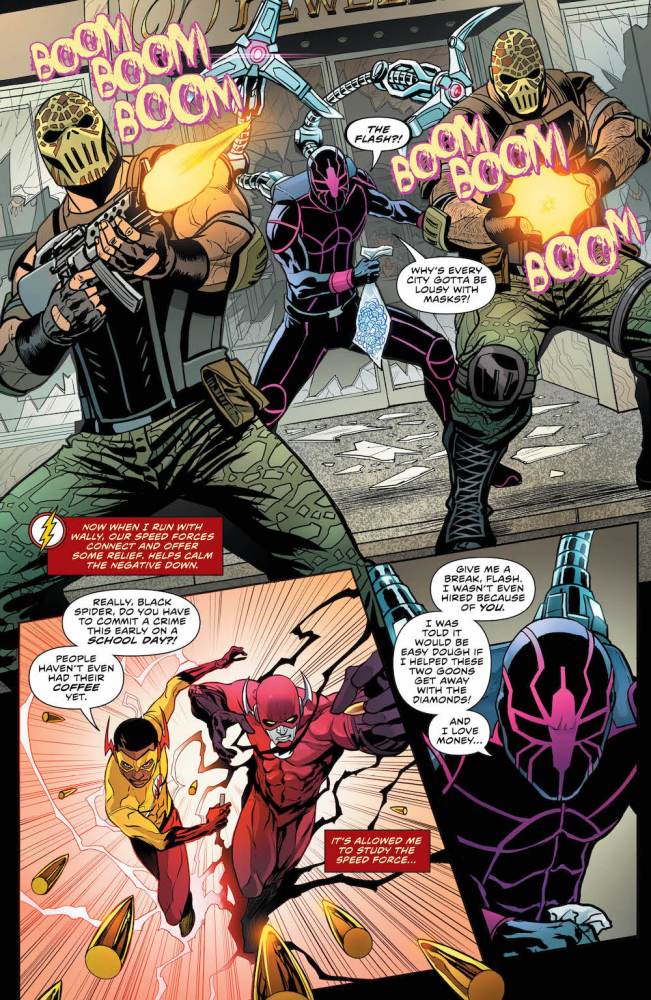
Corrina: The prison system in the DCU is one messed-up system. Arkham is a revolving door for the criminally insane, Belle Reeve is basically a playground for Amanda Waller, and Iron Heights, which has always had an ominous ring, basically allows its prisoners to beat on, bully, and otherwise damage each other. While I agree our real-life prisons need serious reform, the warden here is so over-the-top, he’s practically twirling a mustache at calling these villains sub-human. (Aside: if they are so dangerous, why are they not in solitary confinement, like the real-life Supermax?) Powers seem unpredictable in the DC universe and allowing villains to mix like this seems a singularly bad idea.
But, back to Barry. It’s good to see him and Wally take steps in their relationship but it’s also realistic that the trust between them is going to take longer, just as Barry will have to learn to trust Kristen. (Damn, I feel bad for Kristen. Barry is still a pain in the ass and her career is now a mess too.)
As for the shock appearance at the end, that’s been coming for a while. We’ll see how well it goes.
Good: Ratings 7-8
Gotham City Garage #1 – Jackson Lanzing, Collin Kelly, Writers; Brian Ching, Artist; Kelly Fitzpatrick, Colorist
Ray – 7/10
Corrina: Future Kara
Ray: The latest alternate universe from DC combines the woman-led focus of Bombshells with the post-apocalyptic disaster zone of Injustice, and brings in the crack writing team of Lanzing and Kelly (fresh off the exceptional “Joyride” from Boom). So why does this new universe feel like the least of all of them? Simple – because the DNA strands are just too obvious everywhere. This doesn’t feel like its own property so much as a pastiche of other concepts filtered through the DCU. There’s a distinct Blade Runner vibe to the way Gotham lives now – a high-tech city where everyone is governed by implants, and Governor Luthor rules with an iron fist – that belongs to Batman, who seems to be an evil, corrupted Bruce Wayne in this world.
The main character in this world is Kara Gordon, who was adopted by Jim Gordon as a little girl and is one of the few people whose implant doesn’t effectively regulate her behavior. She’s the best part of this series, a compelling underdog lead who is recognizable as Supergirl while distinctly her own character. She tries to protect the people of the city without detection, but things go badly for her and her father, and she’s forced to flee into the wilderness, where she meets the rebel biker gang of Harley Quinn, Silver Banshee, Big Barda, and Catwoman, and their leader Natasha Irons. This part of the story has a very distinct Mad Max: Fury Road vibe, but these characters barely register in the first issue. I’m not sold yet, but it’s going to benefit from having a strong, unique lead to carry it as it forms its plot.

Corrina: This first issue is basically Kara’s story, the tale of her accepting her powers and abilities for the first time and deciding to make a stand for what’s right. Of course, it goes as badly as things tend to go at the beginnings of rebellion. I liked the relationship between Jim and Kara, don’t know what to think about this Batman, and felt the story failed to make any of the motorcycle-riding female superhero gang members distinctive. As Ray said, that part feels derivative.
It also feels like less fun than I’d hoped. We are in, of course, yet another dystopia.
Batgirl and the Birds of Prey #15 – Julie Benson, Shawna Benson, Writers; Roge Antonio, Artist; Marcelo Maiolo, Colorist
Ray – 7/10
Corrina: Guest-Stars Galor
Ray: This issue is easily the most jam-packed of the series, almost feeling like the kick-off to an event. And it would have been a great start – but it still holds a lot of ongoing character issues, especially when it comes to the guest-stars. It kicks off with Barbara visiting her father in the hospital, as he’s been laid low by a mysterious nasty flu sweeping Gotham. Dinah has Ollie visiting Gotham, fresh from his road trip, and he seems to be unaffected, while Huntress notices all the boys are missing from her classroom, also sick. They check in on Bruce, Alfred, and Dick, and all have been hit by this fast-spreading plague. And it seems like it’s only hitting men. Y: The Last Man comes to Gotham, perhaps?
With a potential plague sweeping Gotham, targeting only one sex, allies start being pulled in. Harley’s role is the biggest problem, as she seems to be interested in curing Joker. First up, Joker isn’t even human if Snyder is to be believed, and Harley hates him now! Wouldn’t she be more interested in saving Mason or Red Tool? And her interaction with Poison Ivy, who is accused of creating the plague at first, is completely off. Selina jumps on board too, worried about Bruce, but they soon run into conflict with Batwoman – who, for the second time this week, can’t seem to handle anti-heroes and is spoiling for a fight. However, by the time Amanda Waller shows up to place Gotham under quarantine, and Wonder Woman joins the team-up (along with Lois Lane, who is investigating the story and is written really well as a daring reporter), it starts to feel like an all-star team-up of DC female heroes. And on that note alone, it’s worth a read.

Corrina: I want to like this story. It has its moments, such as Lois Lane’s bedside manner, and Jim Gordon giving her it back in the same amount. I also like the formation of all the women of Gotham to solve this. And yet, as Ray said, the story is spoiled by a sequence of character problems. First, why is Batwoman so hostile? Heck, she worked with her father, who killed Tim Drake, and the emergency is clear. Seems like she would be more realistic. Then there are the issues with Harley, as Ray has covered, and the issues between Ivy and Harley, and Catwoman seems to be utterly callous if she’s only worried about Bruce.
It’s nice that Wonder Woman showed up at the end but I fear this cast does not yet have a tale worthy of them.
Wonder Woman #32 – James Robinson, Writer; Sergio Davila, Penciller; Scott Hanna, Mark Morales, Inkers; Romulo Fajardo Jr., Colorist
Ray – 7.5/10
Corrina: Characterization/Dialogue Is Off
Ray: After a first issue that wasn’t a Wonder Woman story at all, this issue finally brings the focus back to the character we’re all here to see, and sets her off on an interesting quest. However, there’s still a bunch of nagging narrative problems that pretty much everyone was expecting. The issue opens with Steve and Diana infiltrating a Parademon nest in Paris and going to war against the alien monsters. The timeline jumps back and forth a bit, but overall watching Diana and Steve fight together is fun. However, the dialogue is a bit wonky and repetitive, and Steve’s band of allies (obviously inspired by the movie) feel a bit forced by their inclusion. Still, Robinson clearly gets the central relationship, and it’s good to see Steve continue to be a strong backup to Diana.
Then there’s the main story, which involves the will of Hercules and Diana’s family. I’m not the biggest fan of the Greek Gods origin, much preferring the original backstory, but Robinson (like Azzarello before him) seems interested in actually digging into what it would be like to be a daughter of Zeus. Hercules grappling with his mixed legacy as a hero and choosing Diana as the sole heir to his knowledge and artifacts makes a lot more sense once you read his letter, and oddly, the lawyer who contacted Diana last issue turns out to be a pretty interesting supporting character. But then there’s Diana’s brother, Jason – the Jason from the Argonauts, which would make Diana several thousand years old, no? While I’m willing to give the character a shot, he comes off here in his one scene as very generic. I’m not sure what he’s going to bring to this series.
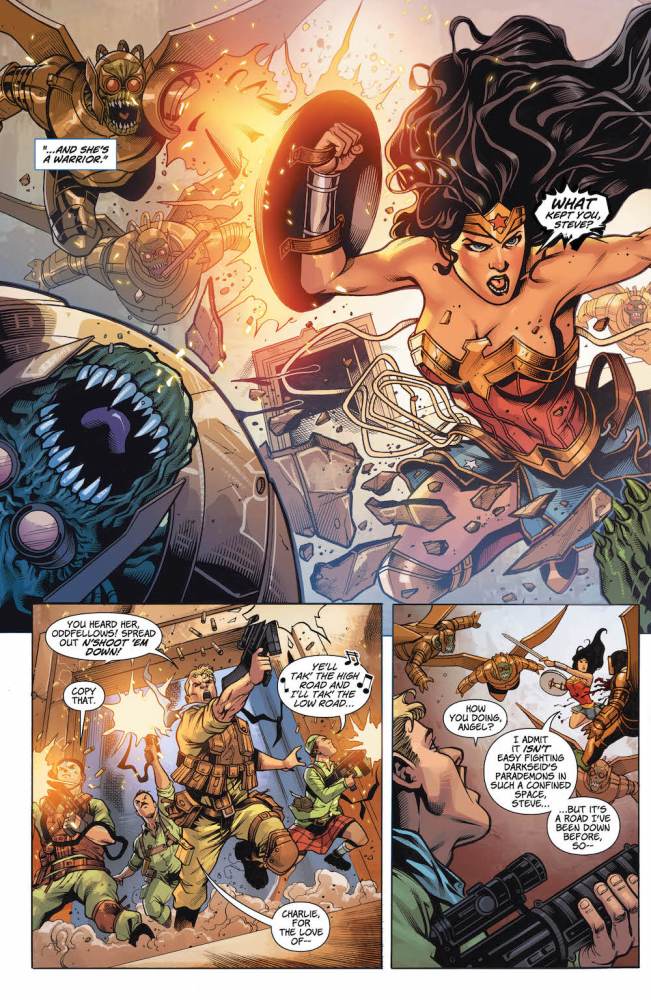
Corrina: There’s a pattern when men write Wonder Woman. (Not all men, of course, such as Rucka.) But too often male writers go over the top in being obvious that “hey, she’s strong and fierce!” You can see it on the page above. And having a whole riff about Steve being arm candy or whatever he’s called, is so out of place in this title and simply addresses an element to their relationship that has never been there and never needed to be there. The dialogue literally made me wince.
As for Jason, we’ve seen too little of him for me to make a decision but this focus on the male scions of Zeus detracts from what may be the eventual showdown between Grail and Diana. Not that I’m sold on Grail as a good foil for Diana but at least then the focus would be on her.
Hal Jordan and the Green Lantern Corps #30 – Robert Venditti, Writer; Patrick Zircher, Artist; Jason Wright, Colorist
Ray – 7.5/10
Corrina: Sinestro? (Right. Inevitable)
Ray: Hal finally returns to Earth for the first time in a while, but unfortunately it’s for a follow-up to a forgettable storyline in another title – the recent Superman vs. Parallax fill-in in Superman. Patrick Zircher’s guest art this issue is the highlight, as he does a great job with big space action and splash pages. The issue is at its most interesting in the opening five pages, much of which is devoted to an elaborate argument between Hal, Guy, and Kyle as they fight over who gets to take on a rare mission to Earth. That mission happens to be investigating Sinestro’s return, which Superman witnessed in that Superman arc. Hal, having the most history with Sinestro, is tapped and heads off to Earth to meet with Superman. Venditti’s Superman is strong, and their initial interaction rings true.
Then, however, as Superman reveals the weird incident that brought him face to face with the fear entity, Hal starts to hear an odd voice, driving him insane. This leads Superman to transform into Parallax. Hal battles to free Superman in an elaborate fight scene, loses – and then wakes up with Superman over him, not remembering any of what Hal saw and saying Hal attacked him out of nowhere, claiming he was Parallax. They soon figure out that the culprit of this fight isn’t actually Parallax – it’s Hector Hammond, locked away and terrified by some evil gremlins, calling out to them for help. What Parallax has to do with this, I’m not sure. The villain doesn’t excite me, but a Hal/Superman team-up is always entertaining and it’s good to see Hal back on Earth.

Corrina: So, at the beginning, John tells the other Earth-born Lanterns about a problem on Earth and lets them argue about it when he’d already decided to send Hal. That’s counterproductive. Why let them argue when he’s already decided? I’m guessing to have a scene where they all talk.
At first, I thought Sinestro is still hiding in Superman but I’m glad he’s not. (I’ll be gladder if that muddled story isn’t referenced again.) I can’t say I’m thrilled with the idea of Sinestro’s return, meaning I was pleasantly surprised with Hammond’s appearance at the end. He’s one GL villain that Venditti hasn’t tackled yet in this series.
Needs Work: Ratings Below 7
Red Hood and the Outlaws #15 – Scott Lobdell, Writer; Dexter Soy, Artist; Veronica Gandini, Colorist
Ray – 6/10
Corrina: Hero Fight. :Sigh:
Ray: After several promising issues that focused on a newly intelligent Bizarro remaking the team to be a utopian crime-fighting machine, this issue, unfortunately, pulls back and gets back to random fight scenes with characters acting out of character to drive the plot. The issue opens with the Belfry crew of Batwoman, Batwing, Azrael, Clayface, and Orphan investigating the sudden disappearance of crime in Gotham, as well as the mysterious high-tech invisible tower that seems to have appeared. Unfortunately, every member of this team seems to have fallen into smug bickering, as opposed to being the odd family they seem like in that book.
There are a few interesting moments early in the issue, such as Ma Gunn finding out a secret about Jason, or Bizarro’s struggle with his slowly fading intelligence. But then, things in the issue take a turn for the worse, as Bizarro is ambushed by the Belfry gang, who have decided to treat the Outlaws like villains who need to be taken down. Given Batman’s relationship with Jason in this book, it seems a bit of a stretch that he wouldn’t have communicated to his team that the Outlaws are allies. Too much of the issue is odd, jumpy action where the two teams punch each other, and usually smart characters like Batwoman seem way too ready to attack fellow vigilantes. This is still overall the series’ best arc, but this issue was a pretty big step downward.

Corrina: This whole “ship in the sky” seems to be an excuse to simply have a fight between the Outlaws and the cast of Detective Comics. That falls flat, in every way, feels out of character for Kate Kane and the rest, and makes this comic a frustrating mess.
Suicide Squad #27 – Rob Williams, Writer; Barnaby Bagenda, Penciller; Jay Leisten, Inker; Adriano Lucas, Colorist; Wilfredo Torres, Backup Artist
Ray – 6/10
Corrina: So, Rick Flagg Sr., Then?
Ray: This is the best issue of this series in a while because it seems to be advancing a new plot that actually has some intriguing mysteries behind it. An eighteen-page main story and a two-page backstory, it serves to deepen the mythology behind the Squad – but it still suffers from the same problem as every other issue, in terms of the lack of any interesting characters and poor characterization for some of the mainstays. Harley still seems obsessed with Rick Flag, for instance. Boomerang doesn’t have anything to do but snark. Amanda Waller treats everyone, even the heroic Katana, with contempt and acts like they’re her puppets.
However, the central plot is fairly strong. When Amanda is nearly assassinated by an old-fashioned robot spider, she splits up the team into two squads. One, led by Deadshot, chases the assassin into the desert, while another led by Katana and Harley heads into space to find the source of the robot. This leads to some old-fashioned sci-fi action, a particularly gruesome monster fight, and a reveal that the history of the Suicide Squad goes back much further than anyone thought – and their original leader may have had ties to a classic Squad character. A backup brings back an iconic DC spy hero, as well. Mythology this issue…pretty interesting. Still suffers from the squad itself lacking, though.
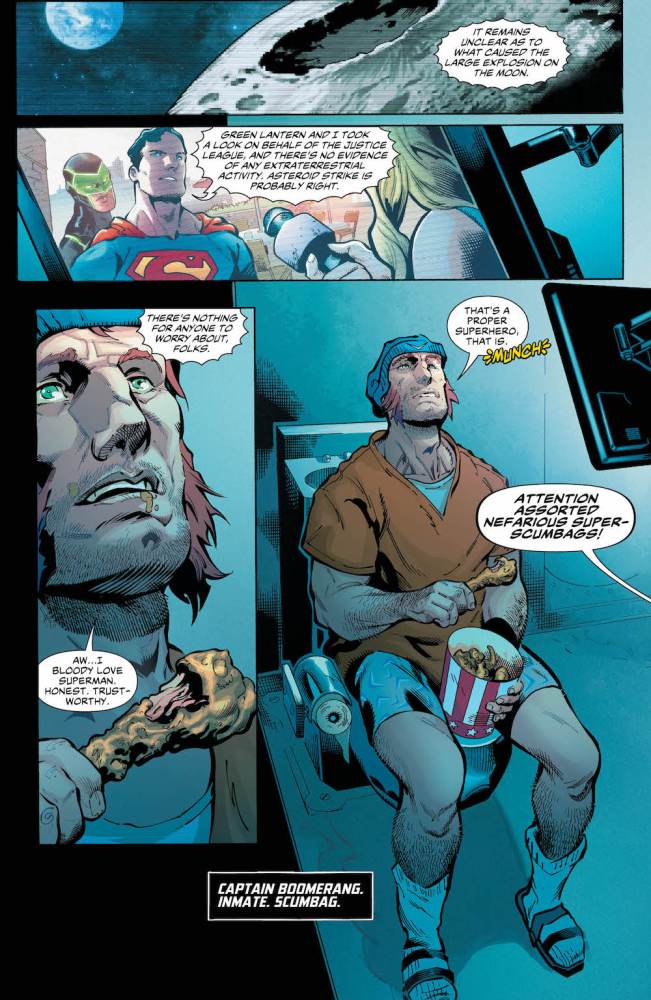
Corrina: The only thing that interested me this issue was Rick & Karin’s appearance. And that’s only because I have a fondness for them from their story in DC: The New Frontier.
Superwoman #15 – K. Perkins, Writer; Sami Basri, Artist; Hi-Fi, Colorist
Ray – 6/10
Corrina: Science Gang Good. But the Title Needs a Focus
Ray: Superwoman’s a title that tries to do way too much, and as it enters its final arc, it still feels like the lead character’s storyarc is nowhere near complete. In the aftermath of the strange diversion last issue involving two Maximas, Lana Lang is again struggling with anxiety and guilt over her powers, trying to figure out where they come from and how to prevent them from hurting the people she loves. She’s pushing herself both at work and in training, and has distanced herself from Steel since their last fight. The best part of this issue is the interaction with the characters she surrounds herself with. This was initially hyped as a team-up book for Lana and Lois, and obviously, that went sideways, but it’s great to see them interacting here again.
The villain, Midnight, is a generic sci-fi monster that seems to come from the internet, gain sentience, and does evil technology things. It’s essentially a plot device, but artist Sami Basri does a great job of lending it a genuinely creepy vibe that enhances the issue a lot. I do like how Lana seems to be forming her own “science girl gang” like we saw in Unstoppable Wasp, consisting of Natasha, Traci, and now the young Maxima (who are all gay, as well, it seems). In many ways, this has been one of the most frustrating titles in Rebirth, because it’s constantly on the edge of doing something interesting, but it suffers from weak antagonists past the first arc and doesn’t seem to have enough of a focus on its main characters.
Corrina: I suspect the problem with this series is that it needs a focus. It started with Lana trying to determine what her powers were doing to her–they seemed to be killing her. Since the first arc with Lena Luthor, it’s been, again, a focus on the powers, their reliability, and what she should do with them.
We still have moved forward from that, not even in a year, and Lana hasn’t even any decisions about what she wants to be and we still know nothing about her powers. This title is sorely in need of some forward momentum.
Scooby Apocalypse #18 – Keith Giffen, JM DeMatteis, Writers; Ron Wagner, Penciller; Ben Caldwell, Artist; Andy Owens, Inker; Hi-Fi, Jeremy Lawson, Colorists
Ray – 5/10
Ray: This series has essentially turned into a cartoon version of Walking Dead. The survivors travel, escape death, and occasionally arrive at what seems like a safe zone and turns out to be anything but. This issue starts in the aftermath of the team’s escape from the monsters, and it turns out that Scrappy-Doo sacrificed himself among a mob of monsters to let the group get away. Which sort of lacks the impact it would have if he hadn’t already sacrificed himself and then turned out to be alive several issues ago. Too many of the interactions are repetitive, although the slow friendship Cliffy and Scooby are forming is sweet in places.
Then it’s time for the group’s next stop, a seemingly idyllic town named Halcyon. Not only is the population still intact and not transformed, but they don’t even really know about the nanobot plague. The team is approached by men at gunpoint when they arrive, and interrogated to see if they can be trusted. They’re then locked in a room and assured they’ll be introduced to the town soon. Overall, there are a few interesting plot bits, but too much of the issue feels very familiar. The backup, by Ben Caldwell, sends Secret Squirrel directly into the Wily Wolf’s lair as this bizarre James Bond pastiche continues to deliver offbeat laughs.
Disclaimer: GeekDad received these comics for review purposes.
